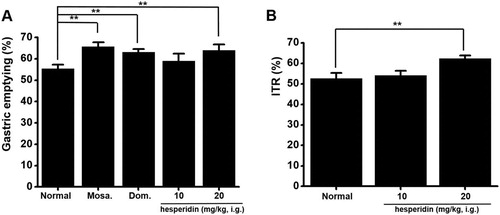Figures & data
Figure 1. Effects of hesperidin on pacemaker potentials of murine small intestine ICC. (A–C) Hesperidin depolarized pacemaker potentials of ICC. (D and E) Summaries of pacemaker potential depolarization and amplitude changes due to hesperidin. Bars indicate mean values ± SEs. **P < 0.01. CTRL: Control.
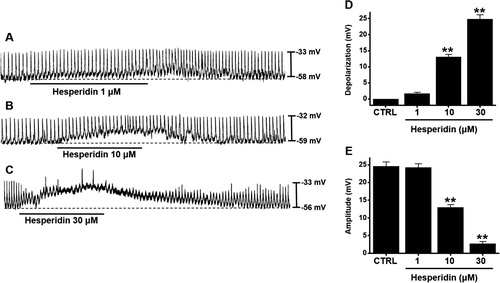
Figure 2. Effects of muscarinic receptor antagonists on hesperidin-induced pacemaker potential depolarization in ICC. (A) In presence of methoctramine, hesperidin depolarized pacemaker potentials of ICC. (B) With 4-DAMP, hesperidin depolarized pacemaker potentials of ICC. (C and D) Summaries of pacemaker potential depolarization and amplitude changes due to hesperidin with muscarinic receptor antagonists. Bars indicate mean values ± SEs. **P < 0.01. CTRL: Control. Methoc.: Methoctramine.
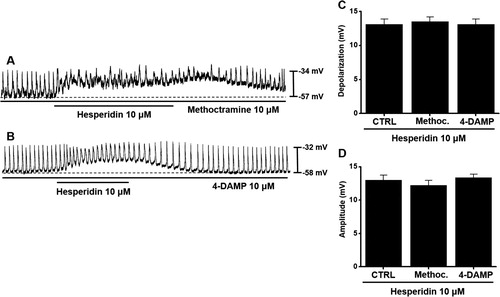
Figure 3. Effects of 5-HT receptor antagonists on hesperidin-induced pacemaker potential depolarization in ICC. (A) In presence of Y25130 (5-HT3 receptor antagonist), hesperidin depolarized pacemaker potentials of ICC. (B) In presence of RS39604 (a 5-HT4 receptor antagonist), hesperidin did not depolarize pacemaker potential of ICC. (C) In presence of SB269970 (a 5-HT7 receptor antagonist), hesperidin depolarized pacemaker potential of ICC. (D and E) Summaries of pacemaker potential depolarization and amplitude changes due to hesperidin with 5-HT receptor antagonists. Bars indicate mean values ± SEs. **P < 0.01. CTRL: Control. Y.: Y25130. RS.: RS39604. SB.: SB269970.
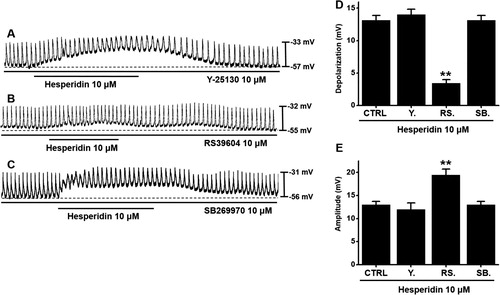
Figure 4. Effects of GDP–β–S on hesperidin–induced pacemaker potential depolarization in ICC. (A) In presence of GDP–β–S (1 mM), hesperidin had no effects. (B and C) Summaries of pacemaker potential depolarization and amplitude changes due to hesperidin with GDP–β–S. Bars indicate mean values ± SEs. **P < 0.01. CTRL: Control.
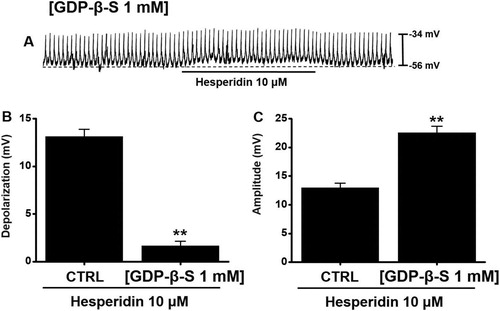
Figure 5. Effects of phospholipase C (PLC), protein kinase A (PKA), and protein kinase C (PKC) inhibitors on hesperidin-induced pacemaker potential depolarization in ICC. (A) In the presence of U73122 (a PLC inhibitor), hesperidin showed no effect. (B) In the presence of KT5720 (a PKA inhibitor), hesperidin depolarized pacemaker potential of ICC. (C) In the presence of calphostin C (a PKC inhibitor), hesperidin showed no effect. (D and E) Summaries of pacemaker potential depolarization and amplitude changes due to hesperidin with PLC, PKA, or PKC inhibitors. Bars indicate mean values ± SEs. **P < 0.01. CTRL: Control.
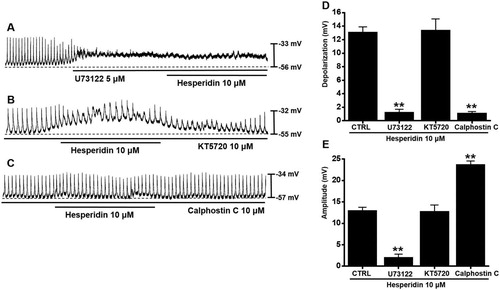
Figure 6. Effect of hesperidin on gastric emptying (GE) and intestinal transit rates (ITR). (A) For comparison, we used mosapride and domperidone. Hesperidin increased GE values. (B) Hesperidin accelerated ITR. Bars indicate mean values ± SEs. **P < 0.01. CTRL: Control. Mosa.: Mosapride; Dom.: Domperidone. i.g.: intragastric.
